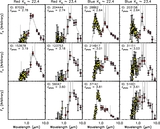The Evolution of the Stellar Mass Functions of Star-forming and Quiescent Galaxies to z = 4 from the COSMOS/UltraVISTA Survey
Abstract
We present measurements of the stellar mass functions (SMFs) of star-forming and quiescent galaxies to z = 4 using a sample of 95,675 Ks -selected galaxies in the COSMOS/UltraVISTA field. The SMFs of the combined population are in good agreement with previous measurements and show that the stellar mass density of the universe was only 50%, 10%, and 1% of its current value at z ~ 0.75, 2.0, and 3.5, respectively. The quiescent population drives most of the overall growth, with the stellar mass density of these galaxies increasing as ρstarvprop(1 + z)-4.7 ± 0.4 since z = 3.5, whereas the mass density of star-forming galaxies increases as ρstarvprop(1 + z)-2.3 ± 0.2. At z > 2.5, star-forming galaxies dominate the total SMF at all stellar masses, although a non-zero population of quiescent galaxies persists to z = 4. Comparisons of the Ks -selected star-forming galaxy SMFs with UV-selected SMFs at 2.5 < z < 4 show reasonable agreement and suggest that UV-selected samples are representative of the majority of the stellar mass density at z > 3.5. We estimate the average mass growth of individual galaxies by selecting galaxies at fixed cumulative number density. The average galaxy with log(M star/M ⊙) = 11.5 at z = 0.3 has grown in mass by only 0.2 dex (0.3 dex) since z = 2.0 (3.5), whereas those with log(M star/M ⊙) = 10.5 have grown by >1.0 dex since z = 2. At z < 2, the time derivatives of the mass growth are always larger for lower-mass galaxies, which demonstrates that the mass growth in galaxies since that redshift is mass-dependent and primarily bottom-up. Lastly, we examine potential sources of systematic uncertainties in the SMFs and find that those from photo-z templates, stellar population synthesis modeling, and the definition of quiescent galaxies dominate the total error budget in the SMFs.
Based on data products from observations made with ESO Telescopes at the La Silla Paranal Observatory under ESO programme ID 179.A-2005 and on data products produced by TERAPIX and the Cambridge Astronomy Survey Unit on behalf of the UltraVISTA consortium.- Publication:
-
The Astrophysical Journal
- Pub Date:
- November 2013
- DOI:
- 10.1088/0004-637X/777/1/18
- arXiv:
- arXiv:1303.4409
- Bibcode:
- 2013ApJ...777...18M
- Keywords:
-
- galaxies: evolution;
- galaxies: fundamental parameters;
- galaxies: high-redshift;
- galaxies: luminosity function;
- mass function;
- Astrophysics - Cosmology and Nongalactic Astrophysics
- E-Print:
- 18 pages paper, 12 pages appendix, 23 figures. Accepted for publication in the ApJ
